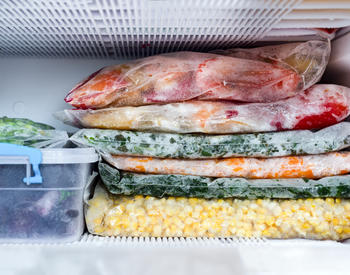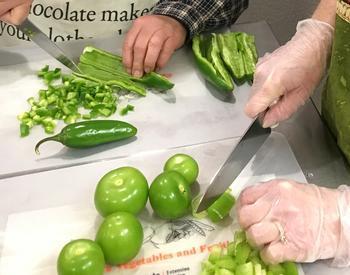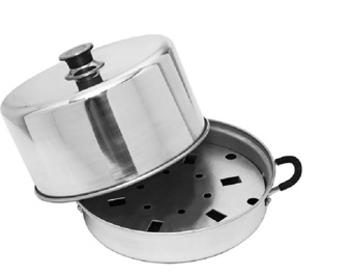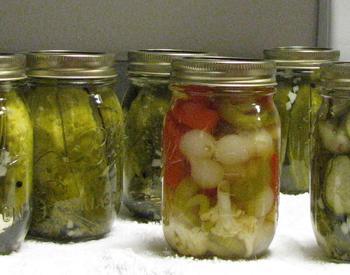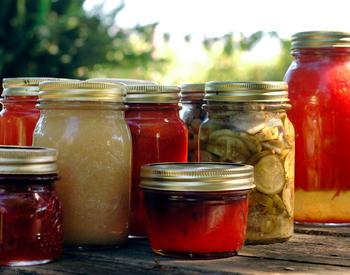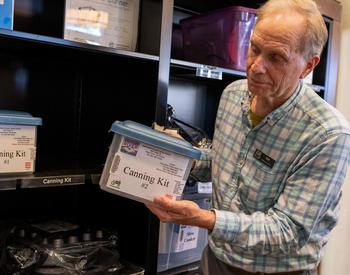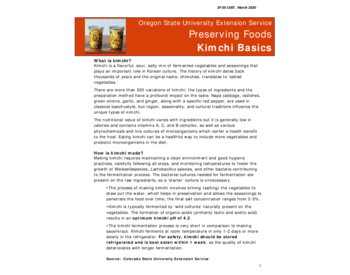Download this publication as a PDF
NOTE: Use this publication for flavored oils not covered in Making Garlic- and Herb-Infused Oils at Home.
It’s important to keep food safety in mind when storing vegetables (such as garlic, mushrooms, chili peppers) or herbs in oil. These low-acid foods can be a source of Clostridium botulinum bacteria, which are found in soil, water and air. Oil’s oxygen-free environment is perfect for growth of the bacteria. For this reason, herbs and vegetables in oil must be stored correctly to prevent botulism food poisoning.
Commercial garlic-in-oil mixtures are acidified to prevent bacterial growth. These products can be stored safely at room temperature. Unfortunately, acidification of homemade herb or vegetables-in-oil mixtures can’t be recommended until research is conducted. Instead, it’s essential to store these hazardous products in the refrigerator or freezer.
When raw or cooked vegetables or raw herbs are stored in oil, Clostridium botulinum bacteria can grow. These mixtures must be refrigerated to slow bacterial growth. A national research study (which included Oregon households) has shown, however, that home refrigerators are often not cold enough to safely store hazardous food such as vegetables and herbs in oil for long periods.
Because harmful bacteria can grow faster at higher refrigerator temperatures, the length of refrigerated storage must be limited for safety. According to conclusions drawn in an analysis of handling procedures (Nummer et al., 2011), vegetables and herbs in oil mixtures should not be refrigerated longer than four days before using, discarding or freezing.
Label containers with the date that the oil mixture was prepared as well as the date (four days later) by which the mixture must be used or else frozen for longer storage.
Storage recommendations
Raw or cooked garlic and/or raw herbs in oil
These mixtures MUST be refrigerated and used within four days or frozen for long-term storage.
Dried garlic and/or dried herbs in oil
If oil is seasoned with dried garlic and/or dried herbs, the mixture MUST be refrigerated and used within four days or frozen for long-term storage.
Dried tomatoes seasoned with garlic and/or herbs
Dried tomatoes-in-oil mixtures with garlic and/or herbs MUST be refrigerated and used within four days or frozen for long-term storage.
Dried tomatoes in oil
Because of their acidity, unseasoned (i.e., no vegetables or herbs), fully dried tomatoes may be safely stored in oil at room temperature. (Refrigeration may delay rancidity, however.)The tomatoes will soften more if quickly dipped in bottled lemon or lime juice before being placed in the oil. The tomatoes can be flavored with dried herbs and garlic.
Dried tomatoes in oil can be used on pizza, pasta salads, appetizers and Italian dishes. The oil can be used in vinaigrette dressing or in a marinade sauce. It can also be used as a dip for French bread.
Mushrooms or chilies in oil
Mushrooms and chilies in oil must be refrigerated unless they have been pickled with vinegar or lemon juice. Mixtures must be refrigerated and used within four days or frozen for long-term storage.
Pesto
Pesto (an uncooked seasoning that includes fresh basil, garlic, pine nuts and oil) must be refrigerated and used within four days or frozen for long-term storage. No researched canning times.
Recipes
Basic pesto
- ¼ cup pine nuts (or sunflower seeds, walnuts, or a combination)
- 3 cloves garlic
- 2 cups fresh basil leaves (or 1 cup basil and 1 cup parsley leaves)
- ¼ cup grated Parmesan cheese
- ¼ teaspoon salt
- ½ cup olive oil
Procedure:
- Finely chop nuts and garlic in a food processor. (A blender can also be used, but it is more time-consuming.)
- Add basil and chop really fine. Add Parmesan cheese and salt. Mix well.
- When everything is well blended, add oil and mix all ingredients together.
- Store pesto in the refrigerator and use within four days or freeze for long-term storage.
Note: Pesto can be frozen in ice cube trays. When frozen, wrap individual cubes in plastic wrap and store in a freezer container.
Fresh vegetables/herbs in oil
Place whole or crushed vegetables and/or herbs in a clean container. Add oil and refrigerate. Use within four days or freeze for long-term storage.
Flavored dried tomatoes in oil
The tomatoes can be flavored with fresh or dried herbs and garlic. To soften tomatoes quickly, dip in bottled lemon juice or 5% vinegar before placing in the oil. Store in the refrigerator and use within four days or freeze for long-term storage.
Related articles
Reference: Nummer, B.A., Schaffner, D.W., Fraser, A.M., and Andress, E.L. Current food safety issues of home-prepared vegetables and herbs stored in oil. Food Protection Trends 31:336-342, 2011.
Developed by Carolyn Raab, PhD., R.D., Extension Foods and Nutrition Specialist, and Margy Woodburn, Ph.D., Emeritus Professor, Nutrition and Food Management.


